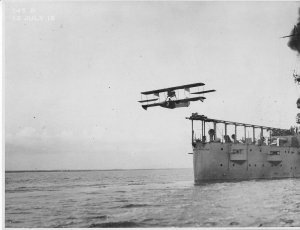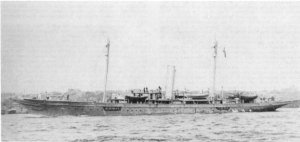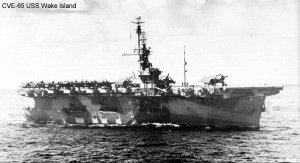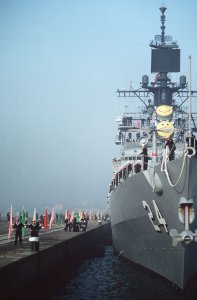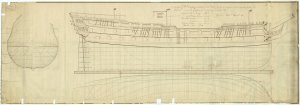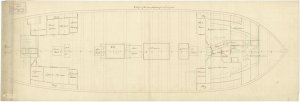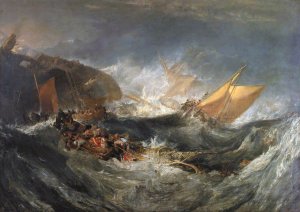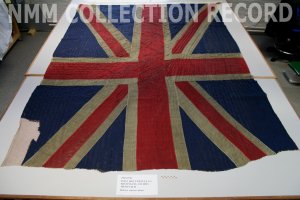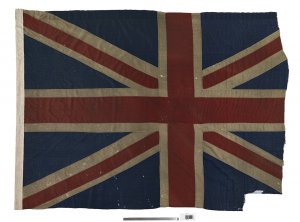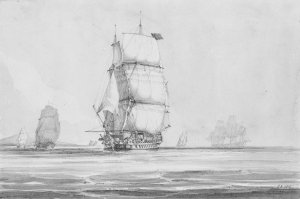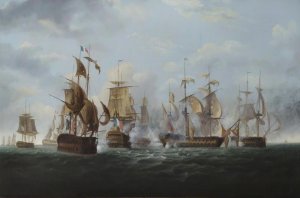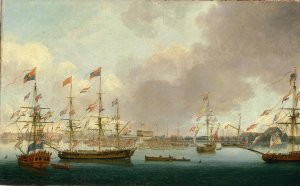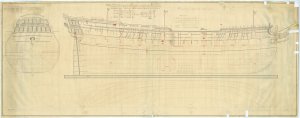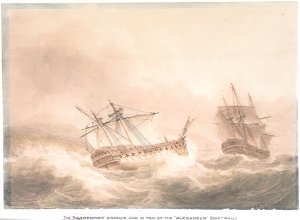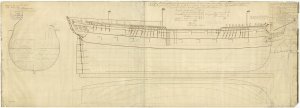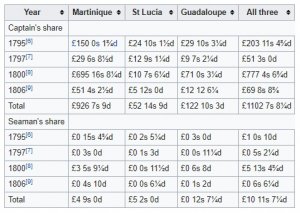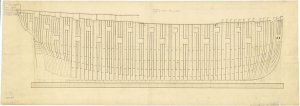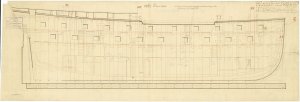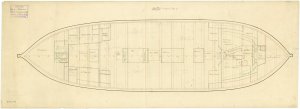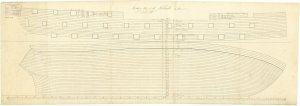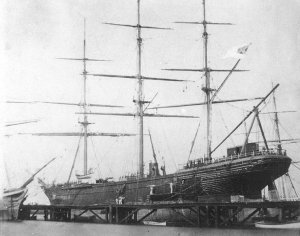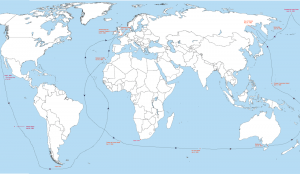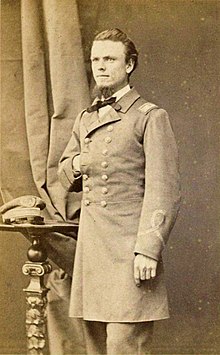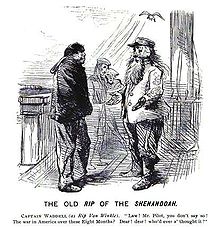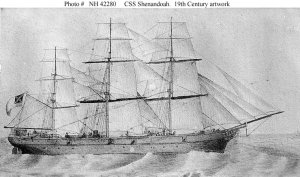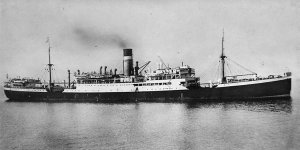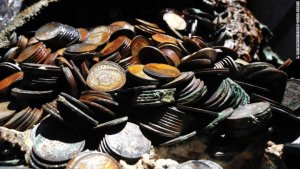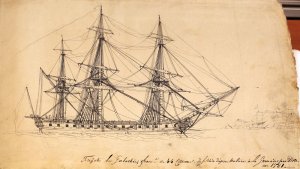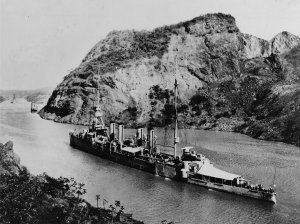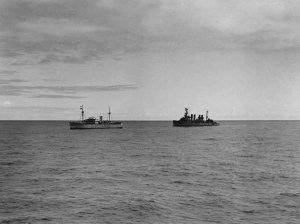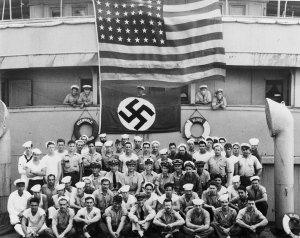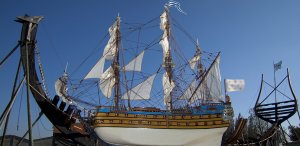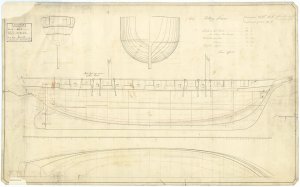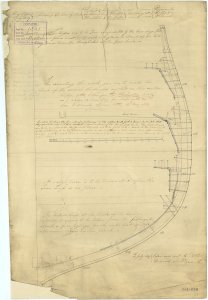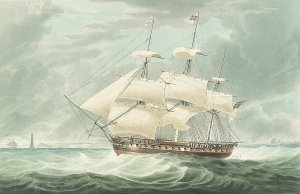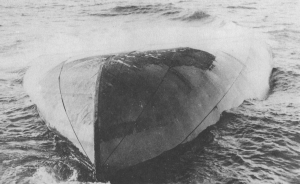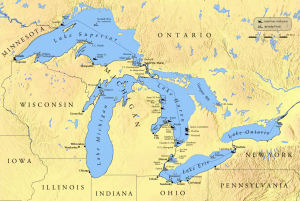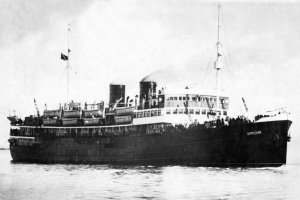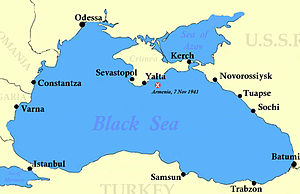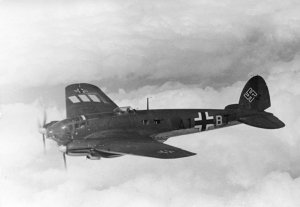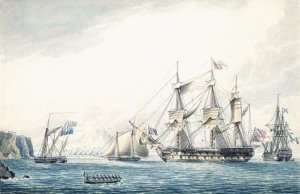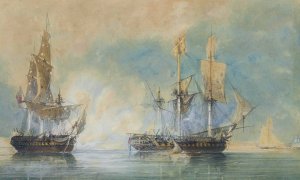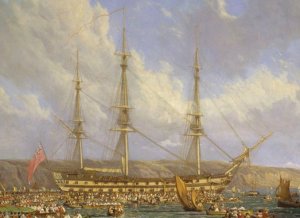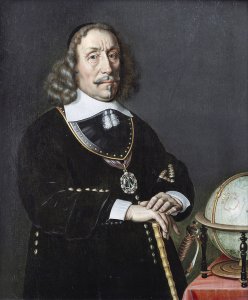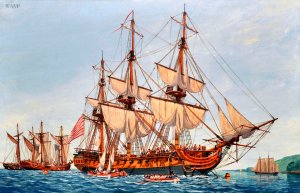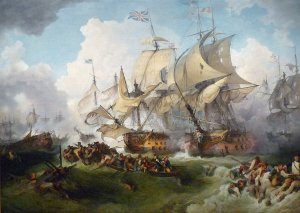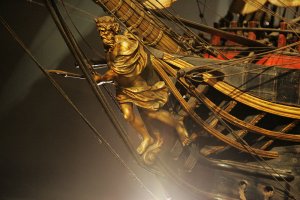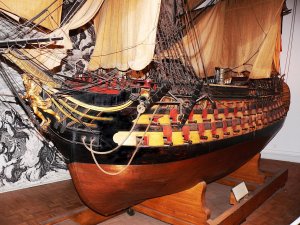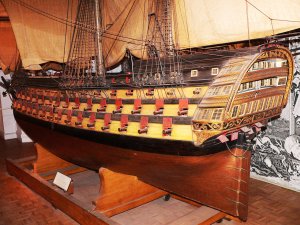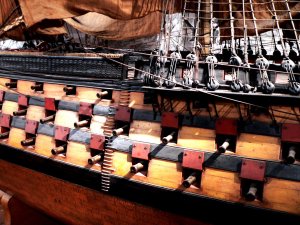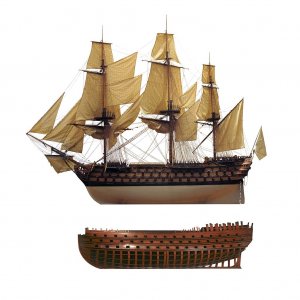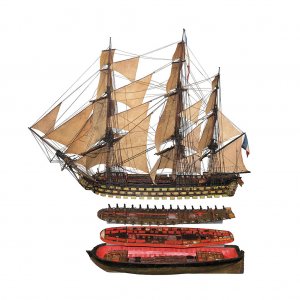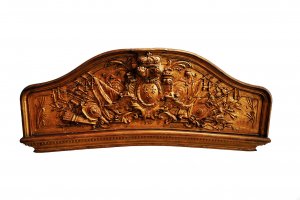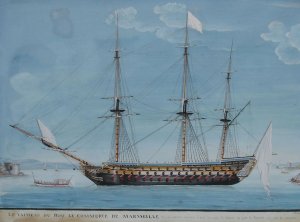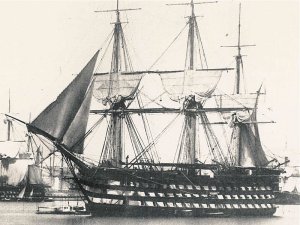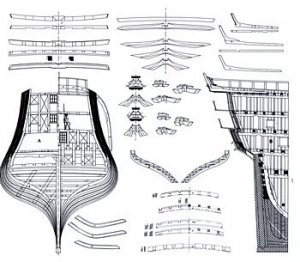Today in Naval History - Naval / Maritime Events in History
5 November 1816 - HMS Briseis (10), George Dourett, wrecked on reef off Point Pedras, Cuba.
HMS Briseis was a 10-gun Cherokee-class Royal Navy brig launched in 1808 at Upnor, on the River Medway.
James Clark Ross joined the Navy in April 1812 and served in this ship under the command of his uncle, John Ross.
On 25 October 1810 Briseis and Snake were in company at the recapture of Ulrica Wilhelmina.
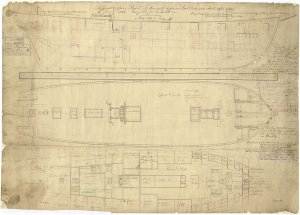
Scale: 1:48. Plan showing the inboard profile, upper deck, lower deck, and platforms for Frolic, a 10-gun Brig as fitted as a Packet. The plan was later altered at the Navy Office and copies sent to the Royal Dockyards for Goldfinch (1808), Redpole (1808), Hope (1824), Magnet (1823), Procris (1822), Weazle (1822), Hearty (1824), Lapwing (1825), Harpy (1825), Fairy (1826), Espoir (1826), Calypso (1826), Recruit (1829), Rapid (1829), Myrtle (1825), Musquito (1825), Briseis (1829, and Hyaena (cancelled 1831), all 10-gun Brigs to be fitted as Packets. Signed by Edward Churchill [Master Shipwright, Plymouth Dockyard, 1815-1830].
Read more at http://collections.rmg.co.uk/collections/objects/84921.html#LVBAkfmOwAROproe.99
Loss
Commander George Dommett sailed Briseis on 24 October 1816 from Trinidad, Cuba, bound for Nassau. On 5 November she sighted unknown land and Dommett sailed closer to attempt an identification of their location. He hove-to for the night off shore only to discover that a current was taking her inshore. Although the crew tried to save her, she grounded. Next morning she fell on her side and filled with water. The crew took to the boats and reached shore safely. There they discovered that they were at Point Pedras, about nine miles west of Bahia Honda on Cuba's northern coast.
The subsequent courtmartial faulted both Dommett's performance, and that of the Master. It sentenced Dommett to two years loss of seniority for "great want of attention". It placed the Master at the bottom of the list of Masters; he was not employed again as a Master for two years.
In fiction
Briseis appears as part of Jack Aubrey's squadron in Patrick O'Brian's The Hundred Days, where she is described as "the little Briseis, one of that numerous class called coffin-brigs" (however, the real Briseis did not serve in the Mediterranean, where the novel's action is set).
Class and type: Cherokee-class brig-sloop
Tons burthen: 239 bm
Length: 90 ft 3 in (27.51 m)
Beam: 24 ft 7 in (7.49 m)
Draught: 11 ft 0 in (3.35 m)
Propulsion: Sails
Sail plan: Brig
Complement: 75 men and boys
Armament:
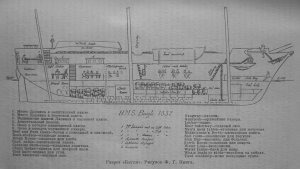
Longitudinal section of HMS Beagle as of 1842
The Cherokee class was a class of brig-sloops of the Royal Navy, mounting 10 guns. Brig-sloops are sloops-of-war with two masts (a fore mast and a taller main mast) rather than the three masts of ship sloops. Orders for 115 vessels were placed, including 5 which were cancelled and 6 for which the orders were replaced by ones for equivalent steam-powered paddle vessels.
Many of these sailing vessels served as mail packet ships, and more than eight assisted with exploration and surveys. The best known of the class was HMS Beagle, then considerably modified for Beagle's second survey voyage under Robert FitzRoy, with the gentleman naturalist Charles Darwin on board as a self-funded supernumerary.
Design
The carronade, nicknamed the "smasher" or "devil gun", was significantly smaller and lighter than conventional cannon. It was also found to have a more destructive broadside at close range, so that a smaller (and cheaper) ship could be more effective in naval actions than a much larger man-of-war. Sir Henry Peake designed a small ship to operate in both shallow and deep waters, carrying eight 16-pounder or 18-pounder carronades plus two long 6-pounder cannon as forward-mounted chase guns.
Henry Peake completed the design for the Cherokee class in 1807. The design was approved on 26 November 1807, with the first four vessels having been ordered in March 1807 but not laid down until December; by the end of 1808 another 30 vessels had been ordered to this design. After these 34, a further 2 were ordered in 1812 which were built of teak at Bombay. The design was revived after the end of the Napoleonic Wars, and another 78 were ordered in two batches between 1817 and 1827. The first batch of these later vessels consisted of 35 orders (of which one was cancelled) whilst the second amounted to 44 new vessels of which 4 were cancelled and 6 replaced by orders for paddle vessels.
The class was much criticised, being popularly known as 'coffin brigs', following the loss by wrecking or foundering of a number of them. There seems to have been no particular fault in their design, but they were considered to be somewhat too small for the global duties they took on. Almost a quarter of them were lost, and they were also nicknamed "Half Tide Rock" as they had low freeboard so the deck was frequently awash with water, and solid bulwarks preventing the water from being shed quickly. William James, in his Naval History written before May 1827, dismissed the supposed design faults, and said that it would be "surprising indeed that the navy board would continue adding new individuals by dozens at a time" to "this worthless class". These open flush-decked ships lacked a forecastle to deflect heavy seas crashing over the bow: one was added to Beagle in 1825 before its first voyage, together with a mizzen mast which improved the handling. Despite these modifications to the design, Captain Pringle Stokes protested that "our decks were constantly flooded".
Further extensive modifications were made for the second voyage of HMS Beagle. Darwin noted in his journal in April 1833 that "It blew half a gale of wind; but it was fair & we scudded before it. — Our decks fully deserved their nickname of a "half tide rock"; so constantly did the water flow over them", but John Lort Stokes who was on all three survey expeditions praised Beagle: "The reader will be surprised to learn that she belongs to that much-abused class, the '10-gun brigs'—coffins, as they are not infrequently designated in the service; notwithstanding which, she has proved herself, under every possible variety of trial, in all kinds of weather, an excellent sea boat."
Service
Few of the Cherokee class ships took part in sea battles of any importance. Large numbers of them went on to serva as passenger and mail carrying packet ships, running from the UK to the USA and Canada.
Several assisted with exploration and survey expeditions, including HMS Barracouta, which served with William Fitzwilliam Owen's survey of African and Arabian coasts between 1821 and 1826 before being converted to a barque-rigged packet in 1829 and then being sold in 1836.
The first voyage of Beagle set out in 1826 under Captain Pringle Stokes as part of Phillip Parker King's survey of South American coasts, which returned late in 1830 with Beagle by then commanded by Robert FitzRoy. Captain Henry Foster commanded HMS Chanticleer on his survey around the South Atlantic, known as his "pendulum expedition", from 1827 to 1831. Chanticleer was then intended to be used for FitzRoy's next survey expedition, but was found to be in poor condition. Instead, the Beagle was repaired and modified for its famed second survey voyage from 1831 to 1836, which took along the naturalist Charles Darwin as a self-funded supernumerary. The Beagle subsequently carried out a survey of coasts of Australia from 1837 to 1843 under John Clements Wickham and John Lort Stokes.
From 1838 to around 1841 HMS Britomart, commanded by Owen Stanley, carried out survey work and other duties around Australia and New Zealand.[11] Other survey ships of this class included HMS Fairy from about 1832 to 1840, Scorpion from 1848 to 1858 and Saracen from 1854 to 1860.
https://en.wikipedia.org/wiki/HMS_Briseis_(1808)
https://en.wikipedia.org/wiki/Cherokee-class_brig-sloop
5 November 1816 - HMS Briseis (10), George Dourett, wrecked on reef off Point Pedras, Cuba.
HMS Briseis was a 10-gun Cherokee-class Royal Navy brig launched in 1808 at Upnor, on the River Medway.
James Clark Ross joined the Navy in April 1812 and served in this ship under the command of his uncle, John Ross.
On 25 October 1810 Briseis and Snake were in company at the recapture of Ulrica Wilhelmina.

Scale: 1:48. Plan showing the inboard profile, upper deck, lower deck, and platforms for Frolic, a 10-gun Brig as fitted as a Packet. The plan was later altered at the Navy Office and copies sent to the Royal Dockyards for Goldfinch (1808), Redpole (1808), Hope (1824), Magnet (1823), Procris (1822), Weazle (1822), Hearty (1824), Lapwing (1825), Harpy (1825), Fairy (1826), Espoir (1826), Calypso (1826), Recruit (1829), Rapid (1829), Myrtle (1825), Musquito (1825), Briseis (1829, and Hyaena (cancelled 1831), all 10-gun Brigs to be fitted as Packets. Signed by Edward Churchill [Master Shipwright, Plymouth Dockyard, 1815-1830].
Read more at http://collections.rmg.co.uk/collections/objects/84921.html#LVBAkfmOwAROproe.99
Loss
Commander George Dommett sailed Briseis on 24 October 1816 from Trinidad, Cuba, bound for Nassau. On 5 November she sighted unknown land and Dommett sailed closer to attempt an identification of their location. He hove-to for the night off shore only to discover that a current was taking her inshore. Although the crew tried to save her, she grounded. Next morning she fell on her side and filled with water. The crew took to the boats and reached shore safely. There they discovered that they were at Point Pedras, about nine miles west of Bahia Honda on Cuba's northern coast.
The subsequent courtmartial faulted both Dommett's performance, and that of the Master. It sentenced Dommett to two years loss of seniority for "great want of attention". It placed the Master at the bottom of the list of Masters; he was not employed again as a Master for two years.
In fiction
Briseis appears as part of Jack Aubrey's squadron in Patrick O'Brian's The Hundred Days, where she is described as "the little Briseis, one of that numerous class called coffin-brigs" (however, the real Briseis did not serve in the Mediterranean, where the novel's action is set).
Class and type: Cherokee-class brig-sloop
Tons burthen: 239 bm
Length: 90 ft 3 in (27.51 m)
Beam: 24 ft 7 in (7.49 m)
Draught: 11 ft 0 in (3.35 m)
Propulsion: Sails
Sail plan: Brig
Complement: 75 men and boys
Armament:
- 8 × 18-pounder carronades
- 2 × 6-pounder guns

Longitudinal section of HMS Beagle as of 1842
The Cherokee class was a class of brig-sloops of the Royal Navy, mounting 10 guns. Brig-sloops are sloops-of-war with two masts (a fore mast and a taller main mast) rather than the three masts of ship sloops. Orders for 115 vessels were placed, including 5 which were cancelled and 6 for which the orders were replaced by ones for equivalent steam-powered paddle vessels.
Many of these sailing vessels served as mail packet ships, and more than eight assisted with exploration and surveys. The best known of the class was HMS Beagle, then considerably modified for Beagle's second survey voyage under Robert FitzRoy, with the gentleman naturalist Charles Darwin on board as a self-funded supernumerary.
Design
The carronade, nicknamed the "smasher" or "devil gun", was significantly smaller and lighter than conventional cannon. It was also found to have a more destructive broadside at close range, so that a smaller (and cheaper) ship could be more effective in naval actions than a much larger man-of-war. Sir Henry Peake designed a small ship to operate in both shallow and deep waters, carrying eight 16-pounder or 18-pounder carronades plus two long 6-pounder cannon as forward-mounted chase guns.
Henry Peake completed the design for the Cherokee class in 1807. The design was approved on 26 November 1807, with the first four vessels having been ordered in March 1807 but not laid down until December; by the end of 1808 another 30 vessels had been ordered to this design. After these 34, a further 2 were ordered in 1812 which were built of teak at Bombay. The design was revived after the end of the Napoleonic Wars, and another 78 were ordered in two batches between 1817 and 1827. The first batch of these later vessels consisted of 35 orders (of which one was cancelled) whilst the second amounted to 44 new vessels of which 4 were cancelled and 6 replaced by orders for paddle vessels.
The class was much criticised, being popularly known as 'coffin brigs', following the loss by wrecking or foundering of a number of them. There seems to have been no particular fault in their design, but they were considered to be somewhat too small for the global duties they took on. Almost a quarter of them were lost, and they were also nicknamed "Half Tide Rock" as they had low freeboard so the deck was frequently awash with water, and solid bulwarks preventing the water from being shed quickly. William James, in his Naval History written before May 1827, dismissed the supposed design faults, and said that it would be "surprising indeed that the navy board would continue adding new individuals by dozens at a time" to "this worthless class". These open flush-decked ships lacked a forecastle to deflect heavy seas crashing over the bow: one was added to Beagle in 1825 before its first voyage, together with a mizzen mast which improved the handling. Despite these modifications to the design, Captain Pringle Stokes protested that "our decks were constantly flooded".
Further extensive modifications were made for the second voyage of HMS Beagle. Darwin noted in his journal in April 1833 that "It blew half a gale of wind; but it was fair & we scudded before it. — Our decks fully deserved their nickname of a "half tide rock"; so constantly did the water flow over them", but John Lort Stokes who was on all three survey expeditions praised Beagle: "The reader will be surprised to learn that she belongs to that much-abused class, the '10-gun brigs'—coffins, as they are not infrequently designated in the service; notwithstanding which, she has proved herself, under every possible variety of trial, in all kinds of weather, an excellent sea boat."
Service
Few of the Cherokee class ships took part in sea battles of any importance. Large numbers of them went on to serva as passenger and mail carrying packet ships, running from the UK to the USA and Canada.
Several assisted with exploration and survey expeditions, including HMS Barracouta, which served with William Fitzwilliam Owen's survey of African and Arabian coasts between 1821 and 1826 before being converted to a barque-rigged packet in 1829 and then being sold in 1836.
The first voyage of Beagle set out in 1826 under Captain Pringle Stokes as part of Phillip Parker King's survey of South American coasts, which returned late in 1830 with Beagle by then commanded by Robert FitzRoy. Captain Henry Foster commanded HMS Chanticleer on his survey around the South Atlantic, known as his "pendulum expedition", from 1827 to 1831. Chanticleer was then intended to be used for FitzRoy's next survey expedition, but was found to be in poor condition. Instead, the Beagle was repaired and modified for its famed second survey voyage from 1831 to 1836, which took along the naturalist Charles Darwin as a self-funded supernumerary. The Beagle subsequently carried out a survey of coasts of Australia from 1837 to 1843 under John Clements Wickham and John Lort Stokes.
From 1838 to around 1841 HMS Britomart, commanded by Owen Stanley, carried out survey work and other duties around Australia and New Zealand.[11] Other survey ships of this class included HMS Fairy from about 1832 to 1840, Scorpion from 1848 to 1858 and Saracen from 1854 to 1860.
https://en.wikipedia.org/wiki/HMS_Briseis_(1808)
https://en.wikipedia.org/wiki/Cherokee-class_brig-sloop




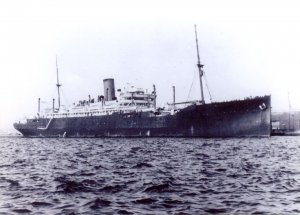
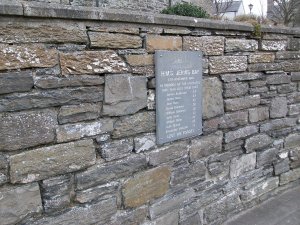
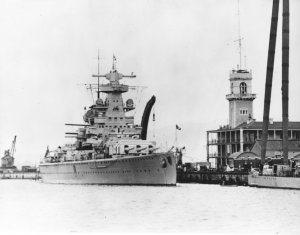
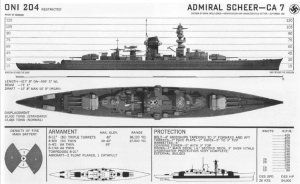
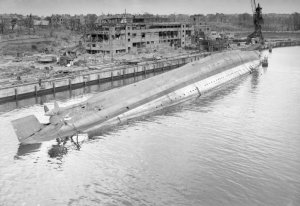
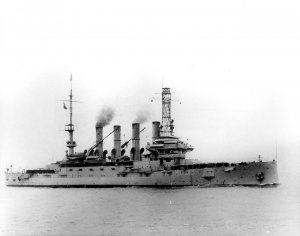
 Shipbuilding
Shipbuilding